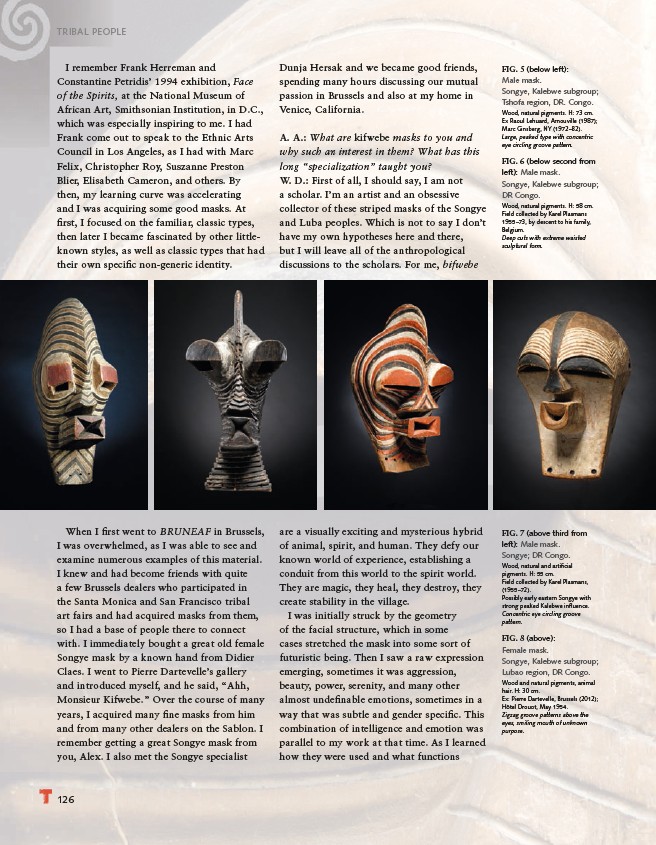
TRIBAL PEOPLE
126
FIG. 5 (below left):
Male mask.
Songye, Kalebwe subgroup;
Tshofa region, DR. Congo.
Wood, natural pigments. H: 73 cm.
Ex Raoul Lehuard, Arnouville (1987);
Marc Ginsberg, NY (1972–82).
Large, peaked type with concentric
eye circling groove pattern.
FIG. 6 (below second from
left): Male mask.
Songye, Kalebwe subgroup;
DR Congo.
Wood, natural pigments. H: 58 cm.
Field collected by Karel Plasmans
1955–73, by descent to his family,
Belgium.
Deep cuts with extreme waisted
sculptural form.
FIG. 7 (above third from
left): Male mask.
Songye; DR Congo.
Wood, natural and artifi cial
pigments. H: 55 cm.
Field collected by Karel Plasmans,
(1955–72).
Possibly early eastern Songye with
strong peaked Kalebwe infl uence.
Concentric eye circling groove
pattern.
FIG. 8 (above):
Female mask.
Songye, Kalebwe subgroup;
Lubao region, DR Congo.
Wood and natural pigments, animal
hair. H: 30 cm.
Ex: Pierre Dartevelle, Brussels (2012);
Hôtel Drouot, May 1954.
Zigzag groove patterns above the
eyes, smiling mouth of unknown
purpose.
When I fi rst went to BRUNEAF in Brussels,
I was overwhelmed, as I was able to see and
examine numerous examples of this material.
I knew and had become friends with quite
a few Brussels dealers who participated in
the Santa Monica and San Francisco tribal
art fairs and had acquired masks from them,
so I had a base of people there to connect
with. I immediately bought a great old female
Songye mask by a known hand from Didier
Claes. I went to Pierre Dartevelle’s gallery
and introduced myself, and he said, “Ahh,
Monsieur Kifwebe.” Over the course of many
years, I acquired many fi ne masks from him
and from many other dealers on the Sablon. I
remember getting a great Songye mask from
you, Alex. I also met the Songye specialist
are a visually exciting and mysterious hybrid
of animal, spirit, and human. They defy our
known world of experience, establishing a
conduit from this world to the spirit world.
They are magic, they heal, they destroy, they
create stability in the village.
I was initially struck by the geometry
of the facial structure, which in some
cases stretched the mask into some sort of
futuristic being. Then I saw a raw expression
emerging, sometimes it was aggression,
beauty, power, serenity, and many other
almost undefi nable emotions, sometimes in a
way that was subtle and gender specifi c. This
combination of intelligence and emotion was
parallel to my work at that time. As I learned
how they were used and what functions
I remember Frank Herreman and
Constantine Petridis’ 1994 exhibition, Face
of the Spirits, at the National Museum of
African Art, Smithsonian Institution, in D.C.,
which was especially inspiring to me. I had
Frank come out to speak to the Ethnic Arts
Council in Los Angeles, as I had with Marc
Felix, Christopher Roy, Suszanne Preston
Blier, Elisabeth Cameron, and others. By
then, my learning curve was accelerating
and I was acquiring some good masks. At
fi rst, I focused on the familiar, classic types,
then later I became fascinated by other littleknown
styles, as well as classic types that had
their own specifi c non-generic identity.
Dunja Hersak and we became good friends,
spending many hours discussing our mutual
passion in Brussels and also at my home in
Venice, California.
A. A.: What are kifwebe masks to you and
why such an interest in them? What has this
long “specialization” taught you?
W. D.: First of all, I should say, I am not
a scholar. I’m an artist and an obsessive
collector of these striped masks of the Songye
and Luba peoples. Which is not to say I don’t
have my own hypotheses here and there,
but I will leave all of the anthropological
discussions to the scholars. For me, bifwebe